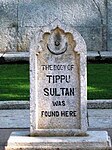
Fourth Anglo-Mysore War
The Fourth Anglo-Mysore War was a conflict in South India between the Kingdom of Mysore against the British East India Company and the Hyderabad Deccan in 1798–99.[5]
This was the final conflict of the four Anglo-Mysore Wars. The British captured the capital of Mysore. The ruler Tipu Sultan was killed in the battle. Britain took indirect control of Mysore, restoring the Wadiyar dynasty to the Mysore throne (with a British commissioner to advise him on all issues). Tipu Sultan's young heir, Fateh Ali, was sent into exile. The Kingdom of Mysore became a princely state in a subsidiary alliance with British India covering parts of present Kerala–Karnataka and ceded Coimbatore, Dakshina Kannada and Uttara Kannada to the British.
Background[edit]
Napoleon Bonaparte's landing in Ottoman Egypt in 1798 was intended to further the capture of the British possessions in India, and the Kingdom of Mysore was a key to that next step, as the ruler of Mysore, Tipu Sultan, sought France as an ally and his letter to Napoleon resulted in the following reply, "You have already been informed of my arrival on the borders of the Red Sea, with an innumerable and invincible army, full of the desire of releasing and relieving you from the iron yoke of England." Additionally, General Malartic, French Governor of Mauritius, issued the Malartic Proclamation seeking volunteers to assist Tipu. Horatio Nelson ended any possibility of help from Napoleon after the Battle of the Nile. However, Lord Wellesley had already set in motion a response to prevent any alliance between Tipu Sultan and France.[6]
Aftermath[edit]
The victors, rather than partitioning the country, forced Tipu's family into exile and restored control of Mysore to the Wadiyars.
Many members of the East India Company believed that Umdat ul-Umara, the Nawab of Carnatic, secretly provided assistance to Tipu Sultan during the Fourth Anglo-Mysore War; and they immediately sought his deposition after the end of the conflict.
The territory of the Nawab of Savanur was split among the English and Maratha forces.
The spot where Tipu's body was discovered under the eastern gate has been fenced off by the Archaeological Survey of India, and a plaque erected. The gate was later demolished during the 19th century to lay a wide road.
In popular culture[edit]
The war, specifically the Battle of Mallavelly and the siege of Seringapatam, with many of the key protagonists, is covered in the historical novel Sharpe's Tiger by Bernard Cornwell.[13]

![The Last Effort of Tippoo Saib at Seringapatam by B. Clayton, 1840[14]](http://upload.wikimedia.org/wikipedia/commons/thumb/a/af/The_Last_Effort_of_Tippu_Sahib_at_Seringapatam_p.334.jpg/200px-The_Last_Effort_of_Tippu_Sahib_at_Seringapatam_p.334.jpg)



